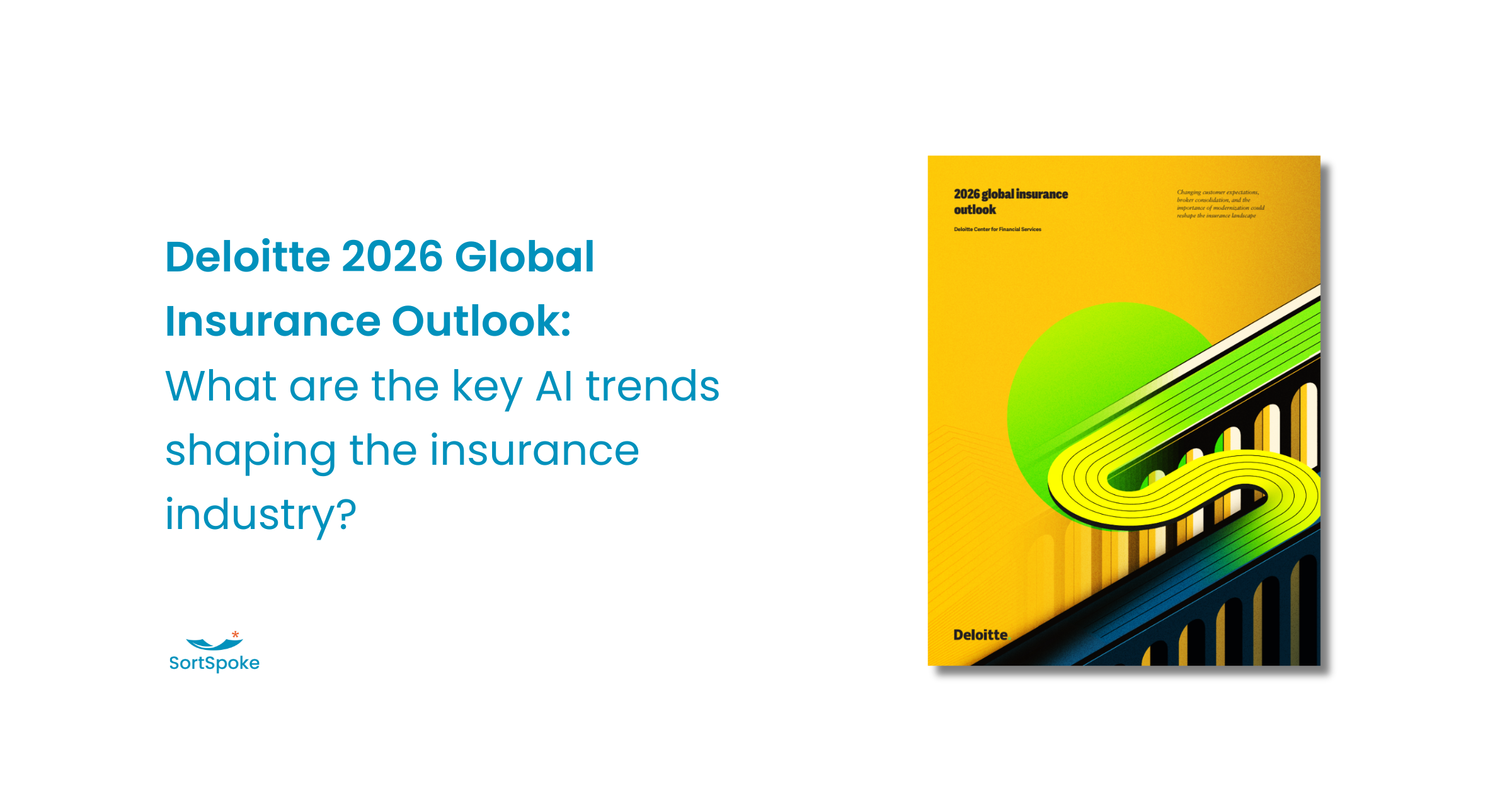
Deloitte 2026 Global Insurance Outlook AI Trends
TL;DR
- AI adoption is shifting from experimentation to execution as insurers move beyond pilots to production-scale implementations with measurable ROI
- Four high-impact use cases are emerging: fraud detection ($160B opportunity), underwriting efficiency (5X productivity gains), claims processing automation, and personalized customer engagement
- Data infrastructure is the foundation – insurers must prioritize data quality, integration, and modernization before realizing AI's full potential
- The human element remains critical – successful AI implementations augment rather than replace human judgment, especially in emotionally complex situations
- A workforce gap threatens progress – while 90% of executives recognize the need to upskill employees for human-AI collaboration, only 25% have taken action
- Geographic differences matter – Asian markets are accelerating through regulatory support, while European carriers focus on foundational data modernization
- 2026 will separate leaders from laggards based on execution capability, not just technology adoption
The insurance industry stands at a pivotal moment. While headlines throughout 2024 and early 2025 trumpeted AI pilots and proofs-of-concept, Deloitte's newly released "2026 Global Insurance Outlook" reveals a fundamental shift: insurers are moving from asking "What can AI do?" to "How do we make AI work at scale?"
This transition matters because the competitive landscape is changing fast. Carriers face mounting pressure from margin compression, slowing premium growth, and escalating operational complexity. Technology alone won't solve these challenges, but insurers who successfully embed AI into their operations—with the right data foundations and workforce strategies—are positioning themselves to thrive in an increasingly uncertain environment.
The report makes one thing clear: success in 2026 won't be determined by who experiments with AI, but by who executes it effectively while keeping humans at the center of the equation.
From Pilots to Production: AI Adoption Accelerates
The experimentation phase is ending. Most insurance leaders have shifted their focus to practical AI use cases with clear return on investment and manageable risk, moving away from exploratory projects toward implementations that deliver measurable business value.
This evolution varies significantly by geography. In several Asian markets like Singapore and Hong Kong, regulators are actively encouraging AI experimentation through grants, sandboxes, and acceleration programs. Singapore's Monetary Authority has launched funding initiatives specifically to promote AI adoption, while Hong Kong's Insurance Authority introduced programs to support AI pilots.
Europe presents a more cautious picture. While insurers like Allianz and AXA are working to unlock agentic capabilities in areas like claims processing, many European carriers remain focused on data modernization and cloud migration as prerequisites to more ambitious AI deployments.
The difference often comes down to regulatory environment and infrastructure readiness. Brazil's Open Insurance framework, which lets customers share data across insurers, is creating an environment that helps carriers overcome legacy constraints and experiment with modern technology solutions. Where regulation supports innovation and data sharing, AI adoption accelerates.
What's driving this shift from pilots to production? Three factors stand out: demonstrated ROI in specific use cases, clearer regulatory guidance in some markets, and growing recognition that competitive advantage will increasingly depend on operational efficiency powered by intelligent automation.
Where AI is Delivering Real Impact
The most successful AI implementations in insurance share a common trait: they address clear, high-value problems. Four areas are emerging as particularly promising.
Fraud Detection: A $160 Billion Opportunity
Fraud detection represents one of the most compelling AI use cases in insurance. Zurich deployed AI technologies to spot claims fraud, using machine learning to detect anomalies in filed claims. The scale of opportunity is staggering: Deloitte estimates that by deploying AI-driven, real-time fraud analytics, P&C insurers could save up to $160 billion by 2032.
This isn't just about catching bad actors. Advanced fraud detection protects honest policyholders from subsidizing fraudulent claims through higher premiums, while helping insurers maintain healthy loss ratios in an increasingly challenging market environment.
Underwriting Efficiency: Doing More with the Same Team
AIG launched a gen AI-powered underwriting assistant built with Anthropic and Palantir that ingests and prioritizes every new excess and surplus submission, allowing review of additional policies without adding new staff. This example illustrates how AI augments rather than replaces underwriting expertise.
The productivity gains are significant. Underwriters spend less time on routine data extraction and organization, freeing them to focus on complex risk assessment and decision-making. This matters particularly as the industry faces persistent talent challenges and knowledge transfer issues as experienced underwriters retire.
Claims Processing: Speed Meets Accuracy
According to J.D. Power's 2024 US Claims Digital Experience Study, overall customer satisfaction with auto and home insurance digital claims experience improved, driven largely by enhancements in the range of services offered on mobile apps and websites and the visual appeal of digital platforms.
Behind these improvements lies AI-powered automation that accelerates initial triage, damage assessment, and payment processing while maintaining accuracy and compliance. In Asia, leading carriers have already gone live with gen AI-driven customer service bots and claims triage systems for "safe" use cases not under strict regulatory scrutiny.
Customer Engagement: Beyond the Chatbot
Customer engagement applications extend well beyond simple conversational AI. Many insurers are investing in AI for customer engagement, including call centers and virtual assistants, but the most sophisticated implementations use AI to personalize product recommendations, optimize communication timing, and predict customer needs before they arise.
The key is connecting these customer-facing applications to robust data infrastructure and ensuring they enhance rather than replace human judgment in high-stakes or emotionally complex interactions.
The Data Quality Imperative: Fix the Plumbing First
Here's an uncomfortable truth: many insurers struggle with fragmented, messy data sprawl and outdated systems that prevent them from realizing AI's value. You can't build a modern AI-powered operation on a foundation of siloed databases, inconsistent data definitions, and legacy systems that don't communicate.
The report emphasizes that to truly "industrialize" AI in insurance and embed it into the very DNA of business processes, insurers should incorporate foundational data readiness and robust technology architecture. This means prioritizing data quality, integration, and master data management for a unified customer view and real-time data processing.
Does this mean every insurer needs perfect data hygiene before deploying AI? Not necessarily. Perfect data hygiene may not be essential for every AI project; however, proper standardization and control can be critical to avoid conflicting results and maintain trust.
The challenge grows more complex when you consider architecture decisions. Some executives, increasingly hesitant to commit to massive multi-year system replacements, are pondering whether AI-driven models might soon render those very systems obsolete. This reflects a fundamental tension: the need to modernize infrastructure while avoiding investments in technology that may be superseded by rapidly evolving AI capabilities.
The most successful approach? Creating adaptable architectures that align with business goals and keeping pace with industry evolution. This requires making strategic choices about which systems to replace, which to enhance with AI layers, and which to maintain while building new capabilities alongside them.
One final consideration: the same drivers energizing the industry, including cloud infrastructure, API connectivity, IoT devices, and AI, also widen the attack surface. Building resilient cyber defenses must be part of any modernization strategy.
The Human Element: Why Empathy Still Matters
The most sophisticated AI implementations share a recognition that technology augments rather than replaces human judgment, particularly in emotionally complex situations.
Insurance is essentially about managing uncertainty and protecting people during some of their most vulnerable moments—a death in the family, a home destroyed by wildfire, or a serious medical diagnosis. In such scenarios, customers aren't just seeking a transaction; they are seeking empathy, clarity, and assurance.
This creates an interesting paradox: as insurers adopt more automation, the human touch becomes a critical differentiator of trust, especially in emotionally complex or high-stakes interactions. The goal isn't to eliminate human involvement but to redirect it toward higher-value activities.
The human-machine collaborative model augments advisors by equipping them with real-time quoting tools, AI-driven product suggestions, and dynamic policy review capabilities. This shift enables them to strengthen customer relationships, deliver more personalized advice, and drive meaningful cross-sell opportunities.
But here's where many insurers face a significant gap. While 90% of insurance executives surveyed agree on the urgency of reinventing the employee value proposition to reflect human-machine collaboration, only 25% of respondents have taken tangible action to elevate human skills.
This disconnect presents both a challenge and an opportunity. Carriers that successfully upskill their workforce, redesign roles to leverage AI capabilities, and create clear career paths in an AI-augmented environment will have a significant competitive advantage in talent attraction and retention.
Key Takeaways for Insurance Leaders
As we move through 2026, several priorities emerge:
The insurance industry's AI journey is accelerating, but success won't be determined simply by who adopts the latest technology. It will be shaped by who builds the right foundations, maintains human judgment where it matters most, and creates organizations where people and AI work together effectively.







